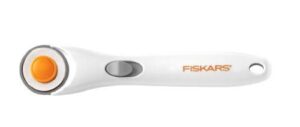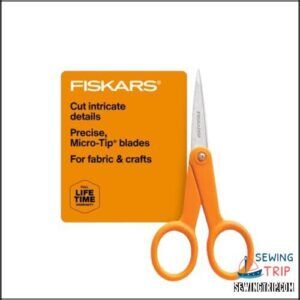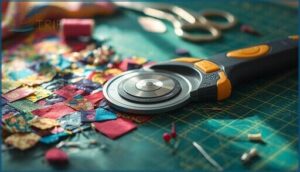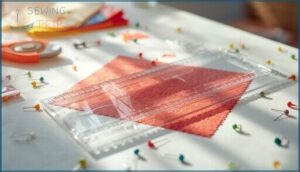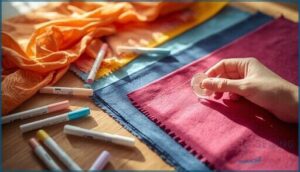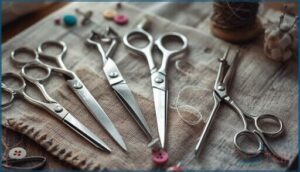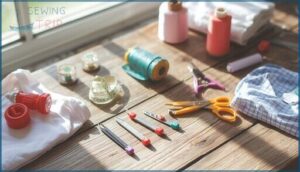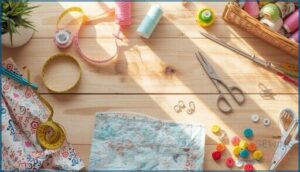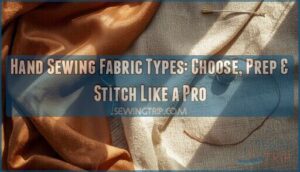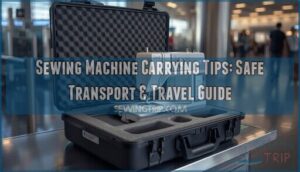This site is supported by our readers. We may earn a commission, at no cost to you, if you purchase through links.
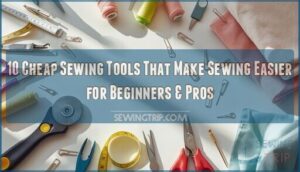
Thread a needle with shaky hands, ruin a perfect cut with dull blades, or watch fabric slide everywhere—it’s easy to think sewing requires expensive gadgets to make things manageable. Here’s the secret: cheap sewing tools can make sewing easier for beginners and seasoned stitchers alike.
Over the years, I’ve seen a humble seam ripper or a five-dollar rotary cutter turn tangled messes into straight seams and smooth edges. Brands may promise miracles, but efficiency blooms when you pick the right, budget-friendly tool for the job.
Discover how these practical tools can change the way your next project unfolds.
Table Of Contents
- Key Takeaways
- Top 10 Cheap Sewing Tools That Make Sewing Easier
- 1. Fiskars Stick Rotary Cutter 28 mm
- 2. Fiskars Self Healing Cutting Mat Grid
- 3. Fiskars Acrylic Sewing and Quilting Ruler
- 4. Fiskars Micro Tip Fabric Scissors Orange
- 5. Gingher Gold Handled Lion’s Tail Scissors
- 6. Sharp Seam Rippers Stitch Thread Remover
- 7. Dritz Quick Turn Fabric Tube Turners
- 8. Clover Hera Fabric Marker Tool
- 9. Wooden Handle Scratch Awl Tool Set
- 10. Mundial 8 Inch Bent Trimmer Scissors
- Essential Budget Sewing Tools for Every Project
- Affordable Tools for Precise Cutting and Marking
- Cheap Sewing Gadgets to Improve Efficiency
- How Inexpensive Tools Simplify Sewing Challenges
- Frequently Asked Questions (FAQs)
- Conclusion
Key Takeaways
- Affordable sewing tools like rotary cutters, self-healing mats, and seam rippers can make sewing easier and more precise, even for beginners.
- Choosing practical, budget-friendly tools helps you tackle common frustrations like fabric shifting, inaccurate cuts, and thread-related mistakes.
- Essential items such as sharp scissors, reliable rulers, and proper machine needles save time, reduce hand fatigue, and improve overall project quality.
- Investing in the right low-cost gadgets simplifies difficult tasks, boosts efficiency, and builds confidence without the need for expensive equipment.
Top 10 Cheap Sewing Tools That Make Sewing Easier
You don’t need to spend a fortune to make your sewing projects run smoother. The right tools can cut your time in half and give you cleaner results without breaking the bank.
Here are ten budget-friendly sewing tools that both beginners and experienced sewers swear by.
1. Fiskars Stick Rotary Cutter 28 mm
When you’re cutting fabric accurately, a good rotary cutter makes all the difference. The Fiskars Stick Rotary Cutter 28 mm stands out among affordable sewing tools with its steel blade material and impressive 4.7-star user ratings. You’ll appreciate its cutting precision for trimming curves and small projects, and the sliding safety features protect you between cuts.
At around $8, this rotary cutter has seen strong market adoption since 2025, with new sewists doubling their use of these efficient cutting tools between 2022 and 2024.
Best For: Quilters, sewists, and crafters who need precise cuts on curves, small-scale projects, and detailed fabric work without spending a lot.
- Excellent cutting precision with edge accuracy within 1 mm when used with a ruler, making it perfect for clean lines and intricate shapes.
- Ambidextrous design works for both left- and right-handed users, with an ergonomic lightweight handle that reduces wrist strain.
- Budget-friendly at around $8 with a lifetime warranty, plus the blade stays sharp for months under moderate use.
- May require extra pressure for crisp cuts and isn’t ideal for cutting multiple layers of fabric at once.
- The 28 mm blade size limits you to smaller-scale projects—you’ll need a larger rotary cutter for bulk cutting tasks.
- Some users find the blade doesn’t feel sharp enough out of the box for their specific needs.
2. Fiskars Self Healing Cutting Mat Grid
Once you’ve got your rotary cutter ready, you’ll need a reliable surface for cutting fabric precisely. The Fiskars Self Healing Cutting Mat Grid protects your table while offering impressive mat durability—most users report 3–5 years of solid use.
You’ll find size options from 12″ x 18″ to 24″ x 36″, with the largest priced around $68–$79. The double-sided design and grid accuracy help you measure and cut in one step, while the self-healing cutting mat’s non-slip surface includes safety features that reduce fabric shifting during your projects.
Best For: Quilters, sewers, and crafters who need a durable work surface that handles large fabric cuts and frequent rotary cutter use over several years.
- Double-sided design with clear grid lines and angle markings gives you 3–5 years of reliable use, with some users extending life even further through simple vinegar soaks.
- Large size options up to 24″ x 36″ let you cut full fabric widths and extra-large squares without repositioning, while the non-slip surface keeps materials steady during cutting.
- Self-healing surface bounces back after cuts and stays accurate for measuring and cutting in one step, making repetitive projects faster and more precise.
- May arrive with a strong chemical smell that takes time to air out, and packaging sometimes leaves sticky residue or doesn’t protect the mat well enough during shipping.
- Grid numbers only print in one direction, which can be awkward depending on how you’re positioned, and certain adhesives like fabric glue can damage the markings.
- Prone to warping if exposed to heat or not stored flat, though you can usually fix it with a hair dryer—and using dull rotary blades wears down the surface faster than it should.
3. Fiskars Acrylic Sewing and Quilting Ruler
A clear acrylic ruler transforms your precision cutting guide setup by letting you see exactly where you’re slicing through fabric. The Fiskars Acrylic Sewing and Quilting Ruler features bright grid lines and highlighted seam allowances that boost measurement accuracy for both sewing and quilting projects.
You’ll find sizes from 4.5″ x 4.5″ up to 6″ x 24″, priced between $20–$40. Non-slip feet prevent shifting during cuts, while angled lines simplify bias strips.
These inexpensive sewing tools make fabric alignment straightforward, improving quilting efficiency without breaking your budget.
Best For: Quilters and sewers who need precise fabric measurements and cuts, especially when working with small squares, bias strips, or projects requiring exact seam allowances.
- Clear acrylic construction with bright grid lines lets you see fabric patterns underneath for perfect alignment and accurate cutting.
- Multiple size options (4.5″ x 4.5″ up to 6″ x 24″) with highlighted seam allowances and angled lines (30, 45, 60 degrees) simplify complex cuts.
- Non-slip feet and optional suction cup handle keep the ruler stable during rotary cutter use, reducing fabric shifting and mistakes.
- Acrylic material can get scratched or damaged by rotary cutters over time, potentially requiring replacement every 6-12 months with heavy use.
- Some users report inadequate packaging leading to shipping damage, and the connecting pieces for extended cuts may lack durability.
- Not suitable for heavy-duty or industrial applications where more robust materials would be needed.
4. Fiskars Micro Tip Fabric Scissors Orange
You need sharp, maneuverable fabric scissors for intricate pattern work and tight curves. Fiskars Micro Tip Fabric Scissors Orange deliver precision cutting with high-grade stainless steel blades that stay sharp through countless projects.
At around $13, these affordable sewing tools offer an ergonomic design with spring-action grips that reduce hand fatigue during detailed trimming. Over 7,600 users rate them 4.8 stars for blade durability and a comfortable ambidextrous grip.
The micro-tip blades slice cleanly through delicate fabrics like silk and cotton, making sewing easier whether you’re clipping seams or shaping appliqués with affordable quality.
Best For: Sewers, quilters, and crafters who need precise control for cutting intricate details, tight curves, and delicate fabrics.
- Micro-tip stainless steel blades cut all the way to the tip and stay sharp through repeated use, handling delicate fabrics like silk and cotton without snagging.
- Spring-action mechanism reduces hand fatigue and strain during extended cutting sessions, especially helpful for users with arthritis or reduced hand strength.
- Ambidextrous design with ergonomic SoftGrip handles provides comfortable control for both right- and left-handed users at an affordable $13 price point.
- Thumb holes may be too small for users with larger fingers, potentially causing discomfort during prolonged use.
- Plastic handle material may raise durability concerns for some users, with occasional reports of handle wear after extended use.
- Made in China, which may be a consideration for users prioritizing specific manufacturing origins or quality standards.
5. Gingher Gold Handled Lion’s Tail Scissors
Your embroidery work deserves scissors built to last a lifetime. Gingher Gold Handled Lion’s Tail Scissors combine double-plated chrome-over-nickel blade material with an ergonomic gold handle design, delivering cutting precision that feels like slicing through butter.
At around $25, these affordable sewing tools aren’t just essential sewing tools—they’re collectible pieces with a lifetime warranty. The 3.5-inch slender blades excel at intricate thread work and delicate appliqué, offering user comfort and professional-grade sharpness that inexpensive tools rarely match. You’ll reach for these scissors project after project.
Best For: Embroidery enthusiasts and sewers who need precision cutting tools for delicate thread work, appliqué, and detailed fabric projects.
- Exceptional sharpness and cutting precision that lasts 8 years with minimal dulling, backed by a lifetime warranty
- Double-plated chrome-over-nickel blades with knife-edge technology cut smoothly through multiple fabric layers without snagging
- Ergonomic bent-handle design reduces wrist strain during extended use, with gold-plated handles that accommodate various hand sizes
- Premium price point of $20-$30 may be steep for casual crafters or those on a tight budget
- 3.5-inch blade size may be too small for general cutting tasks or larger fabric pieces
- Slightly heavier weight compared to standard scissors can cause fatigue during all-day use
6. Sharp Seam Rippers Stitch Thread Remover
Mistakes happen, and that’s where a sharp seam ripper becomes your best friend. These inexpensive tools feature hardened steel blades and ergonomic design that make stitch removal feel easy rather than frustrating.
Market trends show seam rippers are essential sewing tools for both beginners and pros. The blade sharpness cuts threads cleanly on the first try, while fabric protection comes from that small red ball at the forked end.
At under $10, you’re investing in precision that saves time and prevents tears when removing stitches goes sideways.
Best For: Sewers of all skill levels who need reliable tools for removing stitches, fixing mistakes, and altering garments without damaging fabric.
- Sharp hardened steel blades cut through threads cleanly on the first pass, saving time and frustration during seam removal
- Two different sizes (3.5″ and 5″) give you flexibility for detailed work or larger projects
- Ergonomic non-slip handles and protective red ball end make them comfortable and safe to use for extended periods
- Sharp points require careful handling and storage, especially around children
- May struggle with very thick or heavy-duty fabrics that need more robust tools
- Effectiveness depends on working in good lighting and using proper technique to avoid accidentally nicking fabric
7. Dritz Quick Turn Fabric Tube Turners
Turning fabric tubes inside-out used to mean poking chopsticks through tiny straps and hoping for the best. The Dritz Quick Turn changes that entirely with three color-coded cylinders and matching wooden rods that handle tubes from 3/8 inch to over 1 inch wide.
You’ll cut turning time by up to 80% while saving your fingers from strain during repetitive projects. At around $8, this gadget proves size versatility and hand strain reduction don’t require a hefty investment in sewing supplies.
Best For: Sewists and quilters who frequently make fabric straps, ties, or tubular projects and want to save time while reducing hand strain.
- Cuts turning time by up to 80% with three size options that cover most common fabric tube widths from 3/8 inch to over 1 inch.
- Costs around $8 and eliminates the frustration of using improvised tools like chopsticks or safety pins.
- Lightweight kit includes color-coded cylinders and wooden rods that also work for pushing out corners in small fabric pieces.
- Only handles tubular turning tasks, so it won’t help with other common sewing challenges.
- Some users feel the price is high for what’s essentially plastic tubes and wooden sticks.
- Limited to lightweight fabrics like cotton and linen—thicker materials may not work as smoothly.
8. Clover Hera Fabric Marker Tool
Fabric markers that leave ink or chalk residue can permanently stain delicate materials, but the Clover Hera Marker solves this with simple pressure creasing instead of marking.
You’ll create crisp seam allowances and quilting lines without harming your fabric, thanks to its ergonomic design with a small chisel tip and curved reverse-appliqué end.
This inexpensive sewing gadget costs just $5.50 to $7, making it one of the most cost-effective tools for fabric preservation. Beginners and pros alike appreciate how it streamlines quilting applications while eliminating chemical residues entirely.
Best For: Quilters and sewers who need precise fabric marking without ink or chalk residue, especially when working with delicate or light-colored materials.
- Creates clean, temporary crease marks that disappear after stitching, leaving no stains or chemical residue on fabric.
- Extremely affordable at $5.50-$7 with no ongoing costs for refills or replacements, making it a budget-friendly long-term investment.
- Dual-tip design with chisel point for seam allowances and curved tip for appliqué work provides versatility for multiple sewing tasks.
- Crease marks may not show up well on certain fabrics like thick batting or heavily textured materials compared to visible ink markers.
- Requires more physical pressure than pens or chalk, which some users find less convenient than quick marking methods.
- Temporary creases can fade before you finish sewing if you’re working on a project over multiple days or handling fabric frequently.
9. Wooden Handle Scratch Awl Tool Set
When heavy fabrics or leather resist your needle, a wooden handle scratch awl tool set pushes through where thread alone can’t go. This leatherwork awl features a hardened steel blade and ergonomic hardwood handle that fits comfortably in your palm, making awl piercing uses range from pre-punching holes in thick materials to marking stitch lines with precision.
Unlike chisels that create wider cuts, these inexpensive sewing gadgets offer pinpoint control for under $8. Both beginners and pros will appreciate how this beginner sewing essential simplifies working with challenging fabrics while protecting your valuable needles.
Best For: Sewers and leatherworkers who need to pierce thick materials, mark stitch lines, or pre-punch holes for hand sewing projects.
- Sharp hardened steel blade pierces through leather, thick fabric, and paper with ease, making it perfect for heavy-duty sewing tasks where regular needles won’t work.
- Ergonomic wooden handle provides a comfortable, non-slip grip that reduces hand fatigue during extended crafting sessions.
- Incredibly affordable at under $8, offering professional-quality results without the investment required for more expensive tools.
- Sharp metal needle requires careful handling and storage to avoid accidental injuries or damage to other tools.
- Best suited for small detail work and may struggle with heavy-duty industrial applications or very thick leather.
- Wooden handle and thin blade construction may appear fragile to some users, even though the tool performs reliably for typical sewing and craft tasks.
10. Mundial 8 Inch Bent Trimmer Scissors
When precision cuts matter most, Mundial 8 Inch Bent Trimmer Scissors deliver professional results without the steep price tag. The bent blade design lets you trim flat against your work surface, while the ergonomic handle reduces hand fatigue during long sewing sessions.
Hot-drop forged from carbon steel for durability, these scissors maintain their cutting performance through countless projects. You’ll appreciate the adjustable tension screw for customizing blade tightness.
With proper maintenance tips like occasional sharpening, these inexpensive gadgets become reliable tools for beginner sewing enthusiasts and experienced stitchers alike.
Best For: Sewers, quilters, and tailors who need precise, fatigue-free cutting on flat surfaces and want professional-grade durability without spending a fortune.
- Hot-drop forged carbon steel blades stay sharp through heavy use and can be easily re-sharpened for long-term performance.
- Bent handle design allows you to cut flat against your work surface for cleaner, more accurate trimming around curves and edges.
- Adjustable tension screw lets you customize blade tightness for optimal cutting, whether you’re working with delicate fabrics or thick materials.
- Some scissors arrive stiff and tight out of the box, requiring tension adjustment before they cut smoothly.
- Cutting performance at the blade tips can be inconsistent if the tension isn’t properly set.
- Quality control varies—some users report duller blades or faster wear compared to higher-end professional scissors.
Essential Budget Sewing Tools for Every Project
You don’t need to spend a fortune to build a solid toolkit that covers all your sewing basics. A few smart purchases can transform your workspace and tackle the everyday challenges that slow you down.
Here are the budget-friendly essentials that belong in every sewing kit.
Seam Rippers for Quick Stitch Removal
Mistakes happen, and that’s where a seam ripper becomes your best friend. This small tool quickly removes stitches without damaging fabric, saving you time and frustration.
Here’s what makes seam rippers essential:
- Blade sharpness determines how cleanly you’ll remove threads
- Ergonomic design reduces hand strain during extended use
- Stitch removal becomes 10 times faster with proper technique
- Material durability matters—stainless steel outlasts plastic
- User satisfaction stays high even with budget options under $5
Most sewists replace their seam ripper every six months as blades dull. For best results, cut every 1–3 stitches and position the red ball correctly. The best seam rippers offer both precision and comfort.
Whether you’re learning basic sewing techniques or perfecting complex weaving projects, thread trimming becomes straightforward with this adaptable tool.
Self-healing Cutting Mats for Surface Protection
Your cutting mat deserves attention too. Self-healing cutting mats protect your table from rotary cutters and knives while keeping your fabric cutting accurate. These mats feature layered PVC that closes back after each cut, extending mat durability considerably.
Prices start around $7, and proper tool maintenance—like using sharp blades and storing flat—ensures your mat lasts years. Mat safety matters, so avoid heat exposure. For best results, consider using a cutting surface mat to protect your work area.
Fabric Clips and Pins for Holding Fabric
Holding fabric pieces aligned can feel like a juggling act, but you’ve got options. Fabric clips work wonders for thick layers and delicate materials without causing fabric damage—no pinholes in your vinyl or knits.
Pins still shine for precise work, though safety concerns matter for beginner sewers. Most sewists use both based on the project.
The clip vs pins debate really comes down to versatility and user preferences.
Sewing Machine Needles for Smooth Feeding
After you’ve secured your fabric, using sewing machine needles in the right size makes all the difference for fabric feeding and sewing efficiency. A sharp, properly matched needle slides the thread smoothly without resistance or breakage.
Needle quality really matters. Needle size and thread compatibility—especially when switching fabrics—keep your machine running reliably, stitch after stitch, no matter your project.
Tape Measures and Rulers for Accuracy
In sewing, your measuring tape isn’t just a supply—it’s your project’s backbone. Acrylic Rulers and tape measures keep cuts clean and seams straight, but accuracy can slip from measurement drift, user errors, or temperature effects. Sticking with one quality tool boosts reliability.
For beginners, affordable rulers and tapes offer that cost-effectiveness you need for lasting, accurate results.
Affordable Tools for Precise Cutting and Marking
Getting crisp, accurate cuts and clear pattern marks doesn’t take fancy tools. You just need a few reliable basics to see a real difference in your sewing.
Here are some affordable options that make cutting and marking fabric much easier.
Rotary Cutters for Clean Fabric Cuts
Ever tried slicing through fabric like butter? A rotary cutter is your secret weapon for crisp, clean edges. You’ll find your patchwork or garment work sped up and more precise, especially with a self-healing cutting mat beneath. Here’s what makes this affordable tool essential:
- Precision Cutting
- Cutting Techniques made easier
- Ergonomic Grips
- Efficient Fabric Preparation
- Easy Blade Maintenance
Acrylic Rulers for Straight Lines
Acrylic rulers are the backbone of sewing precision, whether you’re quilting, crafting, or making clothes. Their ruler accuracy—down to 0.002 inches—takes the guesswork out of fabric measurement and cutting techniques.
Clear, laser-etched markings mean even beginners cut straight lines with ease. If you want dependable quilting tools and affordable sewing supplies, this small investment pays off every time.
Fabric Markers and Chalk for Easy Pattern Transfer
When you need crisp lines for marking fabric, fabric markers and tailors chalk step up—each with strengths in cost and compatibility. Washable markers come off easily, while chalk offers quick removal and versatility across fabrics.
For marking longevity, test on scraps first. The tracing wheel or chalk wheel brings sharper lines, supporting budget-friendly best practices in your toolkit.
Scissors for Trimming and Detail Work
Looking for clean cuts or sharp finishes? Embroidery scissors slip in close to trim stray threads or add fine detail, while applique scissors and pinking shears handle tricky edges and prevent fraying.
Thread snips save time when moving fast, and a good pair of tailors shears or sharp pointed scissors will make light work of any fabric in your sewing hobby.
Cheap Sewing Gadgets to Improve Efficiency
Some tools aren’t just affordable—they’re real time-savers once you put them to work. If you’re looking to sew smarter instead of harder, a few inexpensive gadgets might make all the difference.
Here are a handful that can help you move through your next project with speed and confidence.
Needle Threaders to Save Time
Have you ever found yourself squinting at the eye of a needle, wishing for a better way? A needle threader changes the game by slashing threading time and error rates, making sewing easier from the start.
It’s a small tool, but it brings big benefits—better accessibility, less wasted material, and a smoother flow, especially for beginners or anyone with dexterity challenges.
Seam Guides for Consistent Seam Allowances
If you’ve ever wished for straighter seams, DIY seam guides and seam guide rulers are your secret weapon. Magnetic seam guides, adhesive seam guides, or even a piece of painter’s tape keep your fabric edge on track, whether you’re new to sewing for beginners or refining your technique. Consistent seams add polish—no fancy sewing supplies required.
Spray Starch and Pressing Tools for Crisp Finishes
Once your seams are lined up, spray starch and pressing tools become your best allies for crisp, professional results. A shot of starch keeps fabric steady and flat, making seam crispness tools like clappers and sleeve boards even more effective.
Play with starch fabric types and pressing efficiency tips—small tweaks in your starch application techniques bring cost-effective finishes to any sewing project.
Bias Tape Makers for Effortless Garment Construction
Just after starching comes another little shortcut—bias tape makers. Instead of fussing with folding and pressing strips by hand, you run fabric through, and out pops perfect tape for any curve or edge. With this tool:
- Create spotless garment finishing
- Boost fabric efficiency using scraps
- Embrace easy sewing automation for DIY projects and new sewing techniques
How Inexpensive Tools Simplify Sewing Challenges
Sewing comes with its fair share of hurdles, but the right tools make all the difference. Affordable gadgets can smooth out common hiccups and take the sting out of tricky tasks.
The right sewing tools turn frustrating tasks into simple solutions, making every project smoother from start to finish
Here’s how simple solutions can help you enjoy sewing from start to finish.
Preventing Fabric Shifting and Misalignment
Ever find fabric layers slipping out of place just when everything’s finally lined up? Simple tools like a walking foot, sewing clips, or pattern weights help keep things steady, especially on tricky seams.
Try spray basting or fabric stabilizers when pinning won’t do. Don’t forget: a little tension adjustment and smart pinning techniques work wonders for managing fabric shifting on any project.
Making Accurate Measurements on a Budget
If you’re searching for an affordable way to keep sewing projects on track, a tape measure with proven accuracy, a clear ruler for visibility, and a reliable seam gauge go a long way.
While marking durability or gauge limitations may pop up, consistent technique verification helps sidestep errors—making budget sewing tools indispensable for sewing projects for beginners and seasoned hands alike.
Handling Thick or Delicate Fabrics Easily
When thick fabric tips matter, it’s usually at the intersection of tool choice and technique. A sharp rotary cutter glides through multiple layers on a self-healing cutting mat; sharp pointed scissors help with trimming detail. For delicate handling, switch needle selection and sewing machine settings to suit the fabric. Reliable sewing machine needles prevent skipped stitches, no matter how challenging the material.
- Use a self-healing cutting mat and rotary cutter for smooth cuts.
- Adjust sewing machine settings for different fabric layering needs.
- Select premium sewing machine needles for thick or delicate fabric.
- Rely on sharp pointed scissors for precision when cutting thick fabrics.
Reducing Frustration for Beginners and Pros Alike
Patience is easier to find when tool accessibility levels the playing field. Inexpensive sewing essentials—like magnetic pinholders and quick-threading needles—reduce missed steps and lost notions, no matter your experience.
These simple upgrades shorten learning curves, slash errors, and boost project enjoyment. Whether you’re just learning or sharpening old skills, the right sewing techniques and tools foster confidence at every level.
Frequently Asked Questions (FAQs)
How to make sewing easier?
When you’re jumping in with both feet, sewing gets easier with a well-organized workspace setup, the right beginner sewing essentials, and simple tool maintenance.
Mastering a few core sewing techniques and tools opens more doors for skill development.
How can I make hand sewing easier?
Hand sewing gets simpler when you organize your needle, use quality thread, and pay close attention to Thread Management.
Secure your Fabric Handling by using clips or pins, and focus on Sewing Ergonomics for better Stitch Quality.
How do you ease when sewing?
Easing techniques in sewing involve placing two rows of long stitches along the curved fabric edge, then gently manipulating and distributing the fabric to fit curves smoothly.
This fabric manipulation helps achieve seam smoothing and stitch control during curve sewing projects.
What tool takes out sewing mistakes?
When you need to fix a sewing mistake, reach for a Seam Ripper or a Stitch Remover. These essential tools make Error Correction simple by safely lifting stitches from fabric, perfect for Mistake Removal and quick Fabric Repair.
How to maintain sewing machine for longevity?
Ever wondered why some sewing machines outlast others? Regular machine cleaning, prompt oil maintenance, fresh sewing machine needles, and protected storage add years to your investment.
Don’t overlook troubleshooting tips or quality accessories like a rotary cutter or self-healing cutting mat.
What are common beginner sewing mistakes?
Many beginner sewists struggle with incorrect thread tension, missed seam allowance, and sewing errors like fabric distortion or skipped stitches.
Overlooking stitch quality, using the wrong needle, and inaccurate measuring quickly turn sewing projects into frustration.
How to select the right sewing needle?
Choosing the right needle means matching Needle Materials and size to your fabric and thread. For lightweight fabrics, use finer needles; for heavy fabrics, select thicker ones.
Regular Needle Maintenance, like swapping a dull needle, ensures smooth sewing.
What is the best thread type for denim?
For denim, prioritize polyester thread or poly-wrapped poly core thread. You’ll get better thread strength, colorfastness, and machine compatibility.
These fiber blends hold up to rugged sewing, frequent washing, and maintain visual impact in garment construction and textiles.
How to troubleshoot tension issues in sewing?
Fix sewing machine Thread Tension by re-threading, changing needles, cleaning lint, and matching thread weight. Check Stitch Appearance—loops or puckering show issues. Adjust tension settings for your Fabric Type, using test scraps. Regular Machine Maintenance prevents recurring needle issues.
Where can I find reliable cheap sewing tools?
Looking for reliable cheap sewing tools? Start with online retailers and specialty websites for deals on essential sewing equipment.
Hardware stores and discount stores offer sewing notions too, while community reviews point to trustworthy online sewing stores and local sewing shops.
Conclusion
Simple solutions shape success, saving stitches and sanity as you start or grow your sewing journey. Cheap sewing tools make sewing easier, opening doors to confidence and creativity that high price tags don’t guarantee.
Each tool has its purpose—guiding fabric, granting precision, or granting peace of mind at messy moments. Invest in what works, not in what’s flashy.
Once these basics fill your toolbox, skill—supported by accessible, practical tools—will always be within your hands’ reach.
- https://www.freepik.com/free-photo/sewing-tools_10093930.htm
- https://quiltscouts.com/2025/01/15/best-rotary-cutters-for-quilting-and-sewing-2025/
- https://www.fiskars.com/en-us/crafting-and-sewing/products/rotary-cutters-mats-and-rulers/fiskars-stick-rotary-cutter-28-mm-1065829
- https://elizabethmadethis.com/rotary-cutter-vs-scissors/
- https://www.youtube.com/watch?v=2_eX4rj4u3I

